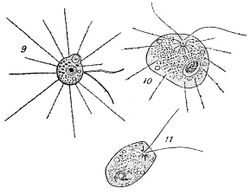Biology:Heliomonadida
From HandWiki
Short description: Order of single-celled organisms
| Heliomonadida | |
|---|---|

| |
| Heliomorpha mutans (= Dimorpha mutans), fig. 9-11 | |
| Scientific classification | |
| Domain: | Eukaryota |
| Clade: | Diaphoretickes |
| Clade: | SAR |
| Phylum: | Cercozoa |
| Class: | Granofilosea |
| Order: | Heliomonadida Cavalier-Smith, 1993 emend. Cavalier-Smith, 2012 |
| Family: | Heliomorphidae Cavalier-Smith & Bass 2009 |
| Genera | |
| |
The Heliomonadida[1] (formerly Dimorphida[2]) are a small group of heliozoan amoeboids that are unusual in possessing flagella throughout their life cycle.
Classification
Genetic studies place them among the Cercozoa, a group including various other flagellates that form filose pseudopodia. This order has recently been placed into the new class of naked filose cercozoans called Granofilosea.[1] There are two genera in this order:
- Heliomorpha, a tiny organism found in freshwater
- the larger Tetradimorpha, which is distinguished by having four rather than two flagella.
Morphology
Bundles of microtubules, typically in square array, arise from a body near the flagellar bases and support the numerous axopods that project from the cell surface.
Dimorphids have a single nucleus, and mitochondria with tubular cristae.
References
- ↑ 1.0 1.1 "Phylogeny of novel naked Filose and Reticulose Cercozoa: Granofilosea cl. n. and Proteomyxidea revised". Protist 160 (1): 75–109. February 2009. doi:10.1016/j.protis.2008.07.002. PMID 18952499.
- ↑ "The twilight of Heliozoa and rise of Rhizaria, an emerging supergroup of amoeboid eukaryotes". Proc. Natl. Acad. Sci. U.S.A. 101 (21): 8066–71. May 2004. doi:10.1073/pnas.0308602101. PMID 15148395.
Wikidata ☰ Q5705752 entry
 |

